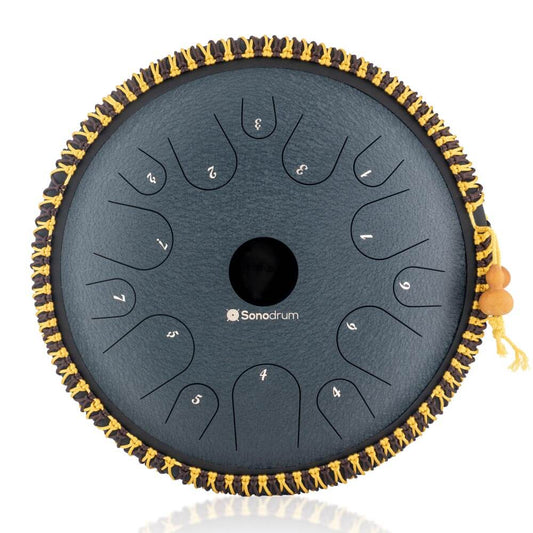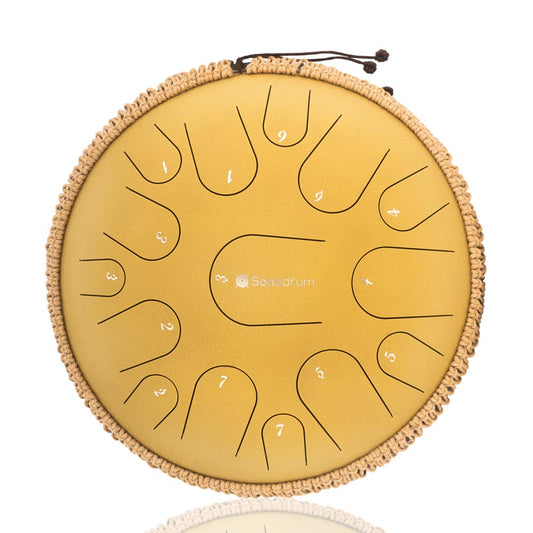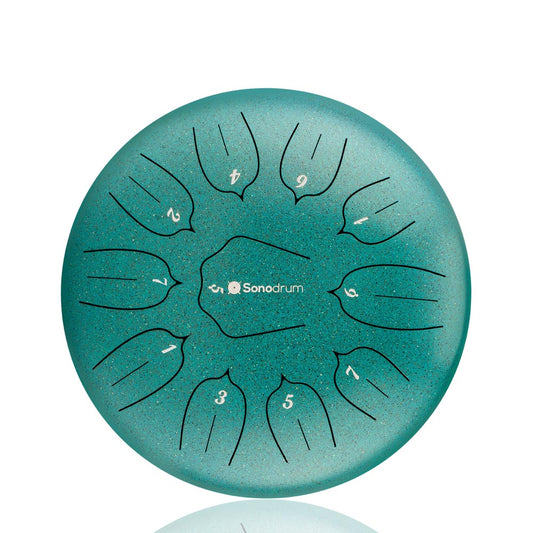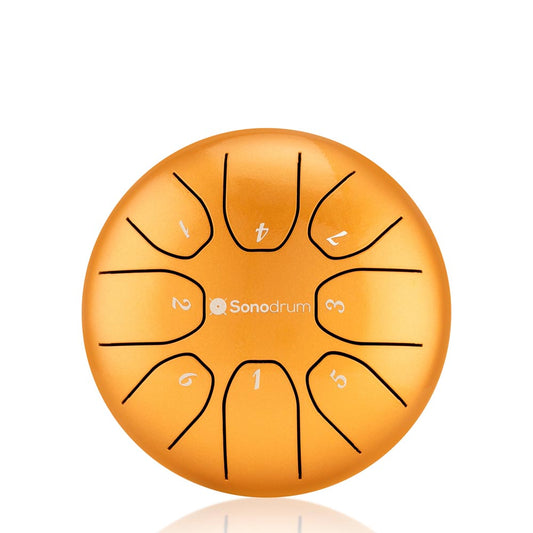The tongue drum, a captivating instrument, invites you into a world of music creation where each note unfolds like a story. This delightful percussion tool harmonizes simplicity with elegance, perfect for those interested in composing melodies that resonate with calm and beauty. As you embark on your sound exploration journey, the unique capabilities of the tongue drum will help you transform even the most basic notes into enchanting music. Get ready to discover composition techniques that will elevate your musical skills, making your practice as inspiring as it is rewarding.
Key Takeaways
- Learn about the soothing qualities of the tongue drum.
- Understand the fundamentals of composing melodies.
- Explore the rich history and cultural significance of the tongue drum.
- Find techniques to unlock your creativity in music creation.
- Discover how emotions influence sound exploration.
The Allure of the Tongue Drum
The tongue drum has captivated musicians and enthusiasts with its unique sound and design. Understanding its characteristics sheds light on what makes this instrument so appealing. Its instrument anatomy highlights various aspects, including how the cut-out tongues contribute to its rich tones. The interplay of size, shape, and material creates a diverse array of sounds, making each drum distinct.
Understanding the Instrument
The tongue drum features play a pivotal role in its sound production. Typically crafted from metal or wood, the drum's resonating body amplifies the musical notes produced by the striking of the tongues. These tongues vary in length and thickness, where shorter tongues yield higher notes and longer tongues produce deeper tones. This varied instrument anatomy offers musicians the freedom to express their creativity through improvisation and composition.
The History of the Tongue Drum
To appreciate the tongue drum fully, one must explore its cultural background. Originating from indigenous cultures worldwide, this instrument has often been associated with traditional music practices. Early iterations of the tongue drum can be traced back to Africa and other regions where rhythm and sound play critical roles in community gatherings and rituals. Understanding its historical context not only reveals its significance but also connects modern players with ancient musical traditions.
How to Compose Simple Melodies on Your Tongue Drum
Composing music on a tongue drum can be a rewarding experience for musicians of all skill levels. Beginning with the right instrument significantly influences your ability to express creativity. Focus on key factors such as scale, size, and material while choosing instruments for melody creation.
Choosing the Right Tongue Drum
Selecting the perfect tongue drum sets the foundation for your compositions. Consider the following elements when making your choice:
- Scale: Different scales evoke various emotions and can guide your songwriting methods.
- Size: The size of the drum affects the tonal range and projection of sound.
- Material: Different materials create distinct timbres, influencing the overall sound quality.
Key Techniques for Composition
Once you've chosen your tongue drum, practice becomes essential. Start by engaging in ear training to develop your musical ear and enhance melody creation skills. You can also explore note pairing as a simple yet effective approach to composing music. Incorporate methods such as:
- Repetition: Reinforce melodies through repeated playing to solidify your compositions.
- Improvisation: Allow yourself to experiment with spontaneous creation, discovering new ideas organically.
Unlocking Your Creative Potential
Exploring the natural world around you can serve as a wellspring of creative inspiration. Nature sounds, from the gentle rustling of leaves to the melodic trickle of a stream, offer unique auditory elements that can deeply influence your musical compositions. By immersing yourself in these environments, you can start to weave their essence into your melodies.
Finding Inspiration in Nature
Take time to observe and listen to your surroundings. Each element in nature contributes a different sound that can shape your musical ideas. For instance, the rhythm of rain may inspire a calm, reflective piece, while the vibrant sounds of birds can lead to more upbeat compositions. Keeping a journal to note these experiences can enhance your creative process.
Using Emotions to Fuel Your Music
Emotional expression in music allows you to convey feelings that words cannot. Reflecting on personal experiences can provide rich emotional landscapes. When composing, think about how different emotions affect the sound of your tongue drum. Do you want to evoke happiness with bright notes, or perhaps sadness with deeper tones? Each note can resonate with human feelings, turning your emotions into a powerful soundtrack.

| Nature Sound | Musical Application | Emotional Response |
|---|---|---|
| Water Flowing | Soft, flowing melodies | Calm, serenity |
| Leaves Rustling | Gentle, rhythmic beats | Peace, nostalgia |
| Birds Chirping | Bright, lively tunes | Joy, uplift |
| Wind Passing Through Trees | Whispering, airy sounds | Reflection, contemplation |
Engaging with these elements enhances your creative inspiration and leads to profound emotional expression in music. By being attuned to both nature and your inner self, you can create melodies that resonate with others on a deeply personal level.
Exploring Different Musical Scales
Understanding musical scales is essential for creating captivating melodies on your tongue drum. This instrument allows for a variety of emotional expressions through its unique tunings. By exploring common scales such as major, minor, and pentatonic, musicians can greatly influence the mood of their compositions, leading to engaging melody variations that resonate with listeners.
Common Scales for Tongue Drums
The major scale evokes feelings of happiness and joy, while the minor scale offers a more melancholic sound. The pentatonic scale provides an easy and versatile way to create melodies that are pleasing to the ear. When learning tongue drum tunings, understanding these common scales can help guide your playing and inspire creativity in improvisation techniques.
Experimenting with Unique Tunings
Beyond the standard musical scales, experimenting with alternative tongue drum tunings can lead to exciting new sounds. Unique tunings open up avenues for innovative improvisation and allow for the creation of distinct melodies. Musicians are encouraged to try different setups, discovering how various scales can transform their musical expression and bring fresh dynamics to their performances.
Performance Tips for Sharing Your Melodies
As you prepare to share your tongue drum melodies, creating an engaging atmosphere becomes essential. A captivating musical environment enhances not just the performance but significantly boosts audience engagement. Implementing effective performance techniques can draw listeners into the musical experience, making them feel a part of it.
Creating a Captivating Atmosphere
Setting the stage for your performance involves careful attention to various elements that contribute to the overall musical atmosphere.
- Lighting: Soft, warm lights can evoke emotions and set the mood, allowing the natural tones of the tongue drum to resonate beautifully.
- Sound Balance: Ensuring that the sound levels are well-balanced allows each tone to shine through, creating a harmonious experience for the audience.
- Arrangement of Space: Organizing the performance area for interaction encourages closer audience engagement, turning passive listeners into active participants.
Engaging Your Audience with Your Sound
Creating a connection with your audience can elevate the live music dynamics significantly. Engaging storytelling and participatory elements can transform a simple performance into an immersive experience.
- Storytelling: Sharing personal stories or the inspiration behind your melodies can create a deeper emotional connection with your audience.
- Interactive Elements: Encourage the audience to respond, clap, or even join in on certain parts of the performance, fostering a sense of community.
- Feedback Loop: Pay attention to audience reactions and adapt your performance accordingly, enhancing the overall dynamic.
By mastering these performance techniques and focusing on creating an inviting atmosphere, you can ensure that your presentation resonates with the audience, enriching their experience with your sound.
Conclusion
In summary, the journey of learning to create enchanting tongue drum melodies is both rewarding and transformative. This article has guided you through understanding the instrument, discovering composition techniques, and finding musical inspiration in various forms. Each section has contributed to a richer appreciation of this unique percussion instrument.
Your musical journey doesn’t need to end here. Emphasizing continuous improvement, it’s essential to keep practicing, exploring different scales, and engaging with your creativity. Allow the sounds of the tongue drum to inspire you as you discover your personal style and expression.
Remember, every melody you compose and share adds to your unique musical tapestry. Embrace the process, experiment with your sound, and most importantly, enjoy the enchanting melodies you'll create along the way.
FAQ
What is a tongue drum?
A tongue drum, also known as a steel tongue drum or handpan, is a percussion instrument made from metal that produces soothing melodies when struck. The cut-out tongues on the surface create varying notes, allowing for beautiful musical improvisation.
How do I choose the right tongue drum for beginners?
When selecting a tongue drum, consider factors such as scale, size, material, and sound quality. Beginners often benefit from a scale that is easy to play, like a pentatonic scale, which avoids dissonance and provides a pleasing sound with minimal effort.
Can I create my own melodies on a tongue drum?
Absolutely! Creating your own melodies is one of the most enjoyable aspects of playing a tongue drum. Start by experimenting with different note pairings and use techniques like ear training to develop your skills and compose simple, catchy tunes.
What are some tips for performance with a tongue drum?
To enhance your performance, focus on creating a captivating atmosphere. Consider your performance space's lighting and sound balance, and engage your audience by telling a story through your music. This helps to foster a deeper connection and keeps listeners interested.
How can I find inspiration for my music?
Inspiration can come from many sources, including nature and personal emotions. Take a walk outdoors, listen to the sounds around you, or reflect on your feelings. These experiences can fuel your creativity and lead to unique musical expressions.
Are there specific musical scales for tongue drumming?
Yes, tongue drums are often tuned to various scales, including major, minor, and pentatonic scales. Each scale conveys different emotions and moods, so feel free to experiment with multiple scales or even unique tunings to discover new sounds and melodies.




